Ugadi (Yugadi) (Hindu new year) information (facts) (history) (significance) (importance) | What is the (real) meaning of new year (Hinduism) | Why Hindu Ugadi is the right day to celebrate new year
Namaste friends, how are you doing today? Welcome to #BhagavanBhakthi website / blog.
Bhagavan Lord Sri Krishna (Vishnu, Rama, Trivikrama, Narasimha, Varaha) and Goddess Lakshmi (Rukmini, Sita) blessings to you and your family!
In this website / blog, you will always learn about #Hinduism #Sanskrit language.
Also subscribe to my YouTube channel from this link #BhagavanBhakthi to view videos about #Hinduism #Sanskrit language.
Just before going to “Ugadi (Yugadi) (Hindu new year) information (facts) (history) (significance) (importance) | What is the (real) meaning of new year (Hinduism) | Why Hindu Ugadi is the right day to celebrate new year“, let us know a brief, basic and very important information.
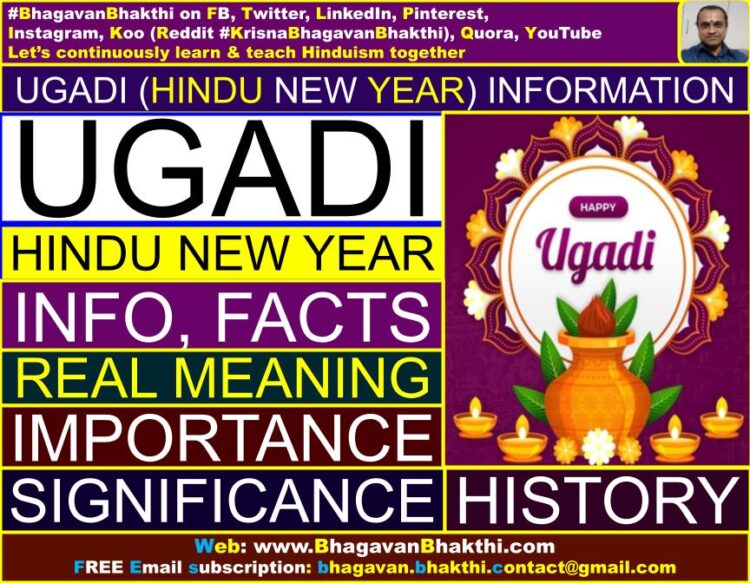
First, let us understand what is the real meaning of new year: The meaning of the new year is that, something new should be happening, seen (weather, environment) etc.
There should be some change in the weather, old leaves should fall and new leaves should grow – the winter season should go and summer season should come, the weather should change, there should be a happy atmosphere around, etc.
If something new happens, then we can call it as a New Year. According to the Sanatana Dharma Panchanga, whatever is said above, they all change in our Chaitra Maas (month) (which comes at the end of March or at the starting of April).
Now you have to decide which new year is to be celebrated. Think about it seriously.
Our Sanatana Dharma is not an ordinary Dharma. It has been started by svayam Bhagavan Lord Sri Hari (Vishnu) himself and has been carried forward by our Rishis (Rushis), ancestors etc. Now it is entirely up to us how we will take it forward.
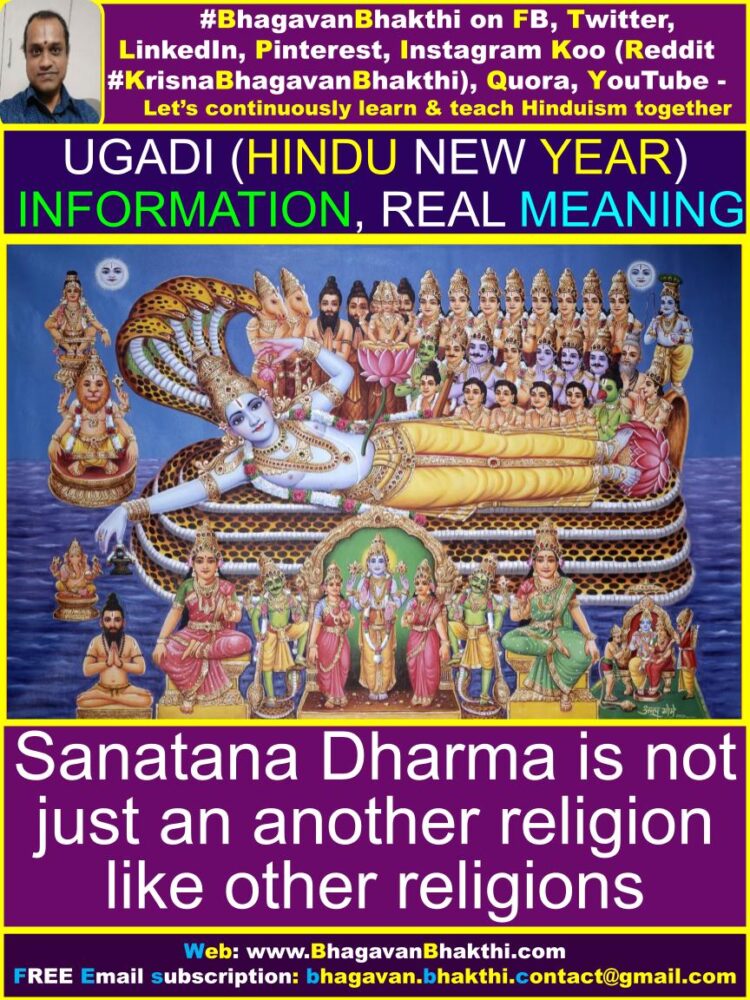
Think wisely and celebrate only the real new year. Now let us all know the real meaning of Hindu new year Yugadi / Ugadi:
Yugadi / Ugadi, is the new year of the Hindu time element. Ugadi marks the beginning of the most auspicious season called Vasanta Ritu (Spring Season). In this season, we find trees start to blossom with colorful flowers. All the trees will be filled with green leaves.
Divine smell will be emanating from the trees and many more things will be happening with the advent of the Vasanta Ritu (Spring Season). Yugadi (Ugadi) is one of the great names of Lord Sri Vishnu.
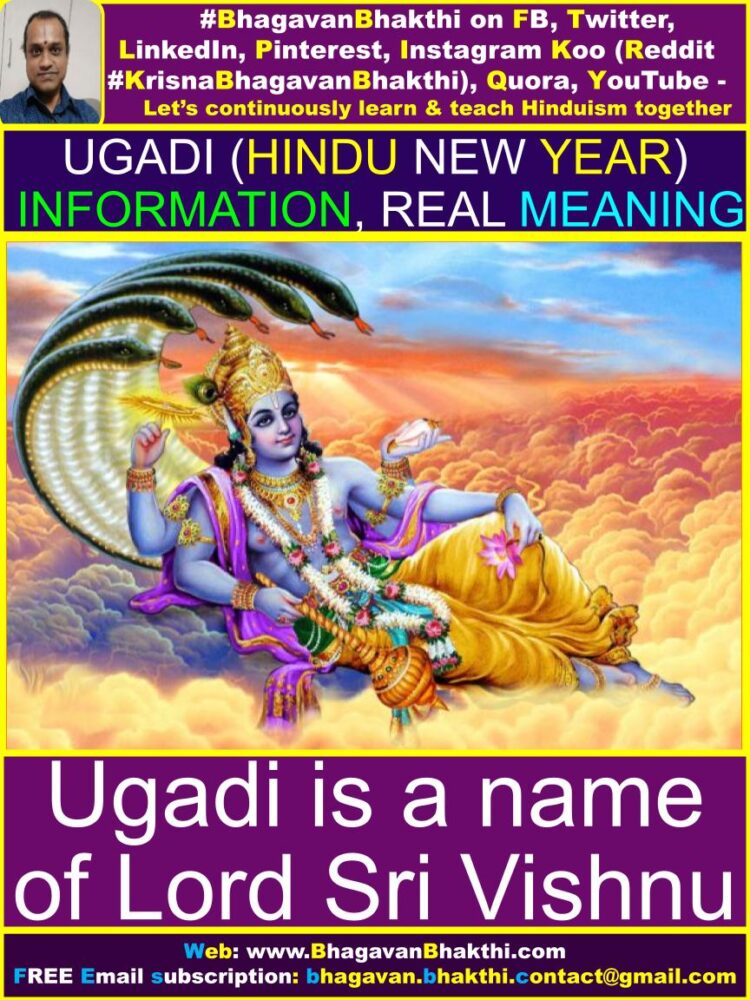
Shloka #33 of Sri Vishnu Sahasra Nama Sthotram describes Bhagavan Sri Maha Vishnu as:
‘Yugadi-krit (युगादि कृत् / yugādi kr̥t)’, that is, someone who creates the Yugas | ‘Yugaavarto (युगावर्तो / yugāvartō)’, that is, someone who is the cause of the repetition of the Yugas (Eras) |
Hence, it is the perfect time to celebrate this day with the worship of the Para Brahma, that is, svayam Bhagavan Sri Maha Vishnu, who is the cause and effect of this infinite ‘Time Element’.
As per the Hindu Chandramana Panchanga / Lunar Calendar, first day (Prathama tithi – first day) of Shukla Paksha (Bright fortnight) – in Chaitra Maasam is considered as the day on which the Creation had started, that is, this marked the beginning of ‘Sri Sveta Varaha Kalpa’.
This day is being referred to as Kalpaadi. (Here Kalpaadi = Kalpa + aadi = Starting of a new Kalpa.) It is also considered as the day on which the Yuga (new era started) had commenced and hence, it is also referred to as Yugaadi or Ugadi.
(Here Yugaadi = Yuga + aadi = Starting of a new era / Yuga.)
As per the jyotishya / astrological (movements of the star and planets) estimates, it is said that Bhagavan Lord Sri Krishna’s Niryaana (Leaving the earth – There is no birth or death to him) took place at the early hours on the ‘pratipada’ (that is, first day of the bright fortnight).
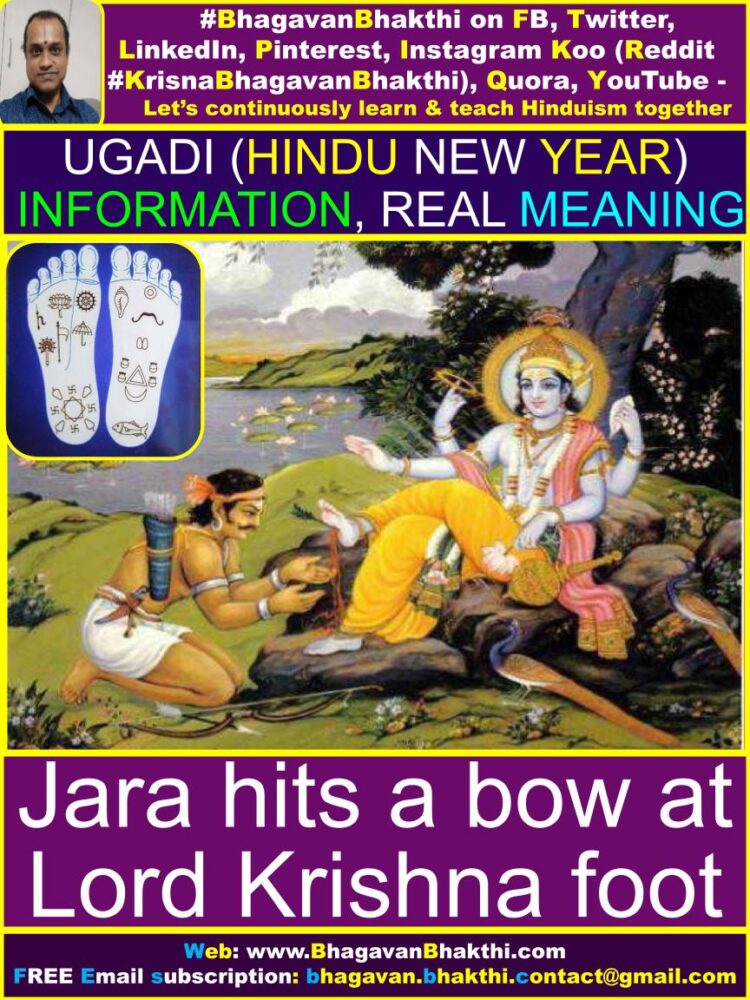
This is as per the ‘Chandramana Panchanga’ (lunar month) of ‘Chaitra Masam’ (Chaitra month) corresponding to 18.02.3102 BC that marked the beginning of the Kaliyuga. Hence, Yugaadi / Ugadi may also be assumed as the starting of Kaliyuga.
In the concept of Ugadi, the ‘samvatsara’ (sixty year cycle) has the following names:
Samvatsara / Year name is as given below:
Prabhava | Eeshwara | Sarvajittu | Hevalambi | Plavanga | Pingala | Vibhava | Bahudhaanya | Sarvadhaari | Vilambi | Keelaka | Kaalayukthi | Shukla | Pramadhi | Virodhi | Vikaari | Saumya | Siddharthi | Pramoda | Vikrama |
Vikruthi | Saarvari | Saadhaarana | Raudra | Prajapathi | Vrusha | Khara | Plava | Virodhikrit | Durmathi | Angeerasa | Chitrabhanu | Nandana | Shubhakrut | Paridhavi | Dundubhi | Shrimukha| Subhanu | Vijaya | Shobhakrut |
Pramaadee | Rudhirodgaari | Bhaava | Taarana | Jaya | Krodhi | Aananda | Raktaakshi | Yuva | Paarthiva | Manmata | Vishvavasu | Raakshasa | Krodhana | Dhaata | Vyaya | Durmukha | Paraabhava | Nala | Akshaya |
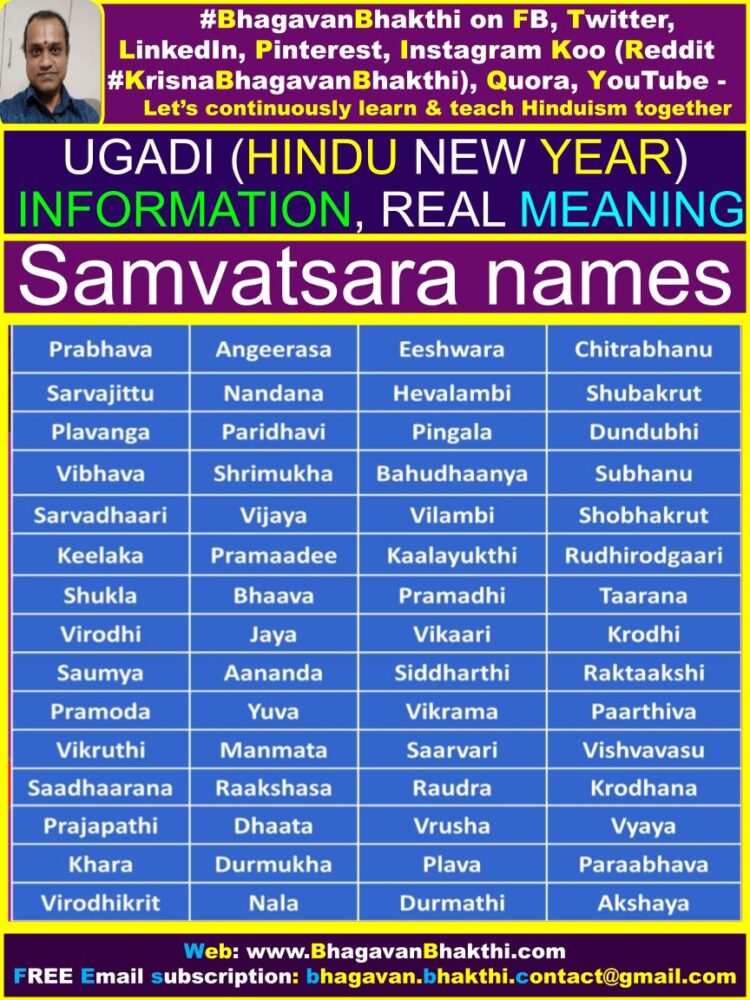
As per a popular legend, all these sixty names are said to have been related with the divine Devarshi Narada. He is one of the Brahma Manasa Putras (son born from the mind of Sri Brahma Deva).
Devarshi Narada is a great gnani / scholar, saint and Philosopher depicted as a Divine Messenger of the ‘triloka’ (three worlds). In all the ‘Dharma kathas’ (stories as per Hinduism Shastras / scriptures) we usually find Devarshi Narada playing a pivotal role and his involvement in one way or the other is very important.
As per a legend, once upon a time Devarshi Narada caught in the mystery of Sri Maha Vishnu’s Maya (that is, illusion). Added with a curse from Sri Brahma Deva, Devarishi Narada had to become a damsel with a desire to experience the materialistic life.
In the meanwhile, that Damsel marries a Raja / King and gives birth to 60 sons. Later, as time passes Raja / King along with his 60 sons dies in a battle.
Suddenly, the grief stricken Damsel (Devarshi Narada) came out of illusion with Bhagavan’s mercy and realized, that it was the ‘Maya’ (illusion) of Bhagavan Lord Sri Vishnu.
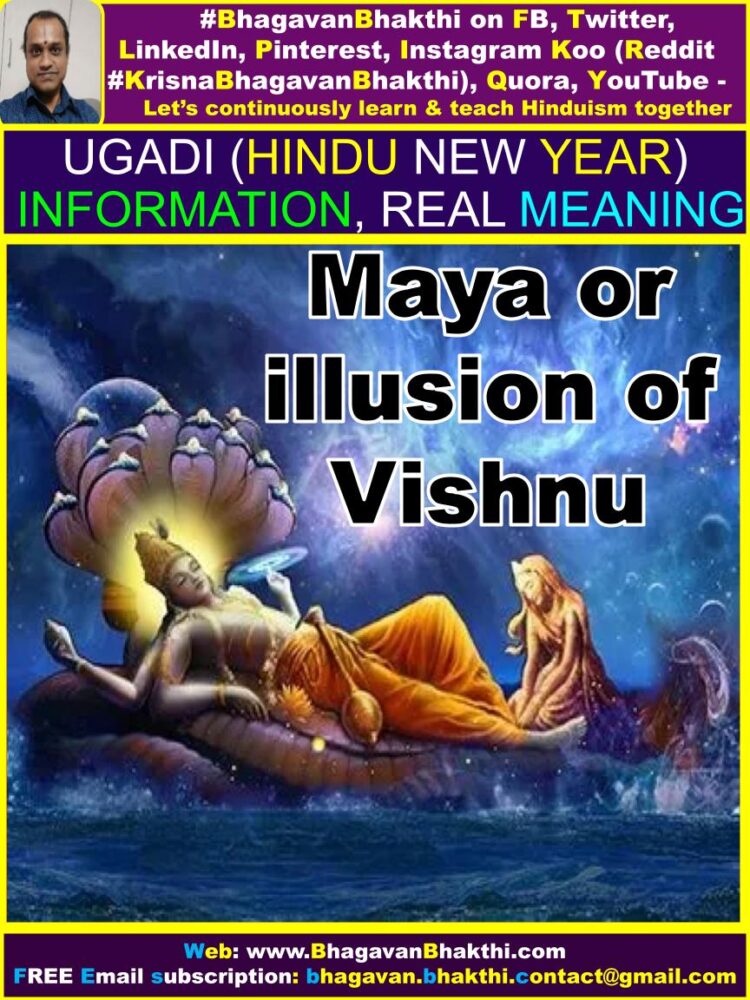
In memory of Damsel’s (Devarshi Narada) sons and to give eternity to their names, Bhagavan Sri Maha Vishnu blessed them that henceforth, the sixty year cycle of Hindu time element will be represented by their names.
Ugadi signifies the current period, in which we are living as per the Hindu time element in a 60 year cycle, with each new year (Ugadi) denoted by an unique name starting from ‘Prabhava’ and ending with ‘Akshaya’. This cycle will keep on continuing.
In few places of North India, people follow the calendar as per the ‘Vikrama Sakha’ and accordingly the commencement of New Year differs a little bit. There, it starts from the first day of ‘Chaitra Bahula Paksha’ known as Baisakhi.
In Gujarat it will be from the first day of Kartika Maasam after Deepavali Amavasya. Even in South India, where ‘Shalivahana Sakha’ is followed, commencement of the ‘New Year’ is observed on two different dates.
In case of Andhra Pradesh, Karnataka, Maharashtra and Goa, Ugadi is observed on the first day of Shukla Paksha in ‘Chaitra Masam / Month’ as per the Lunar Calendar known as Chaandramana Panchanga (चान्द्रमान / cāndramāna).
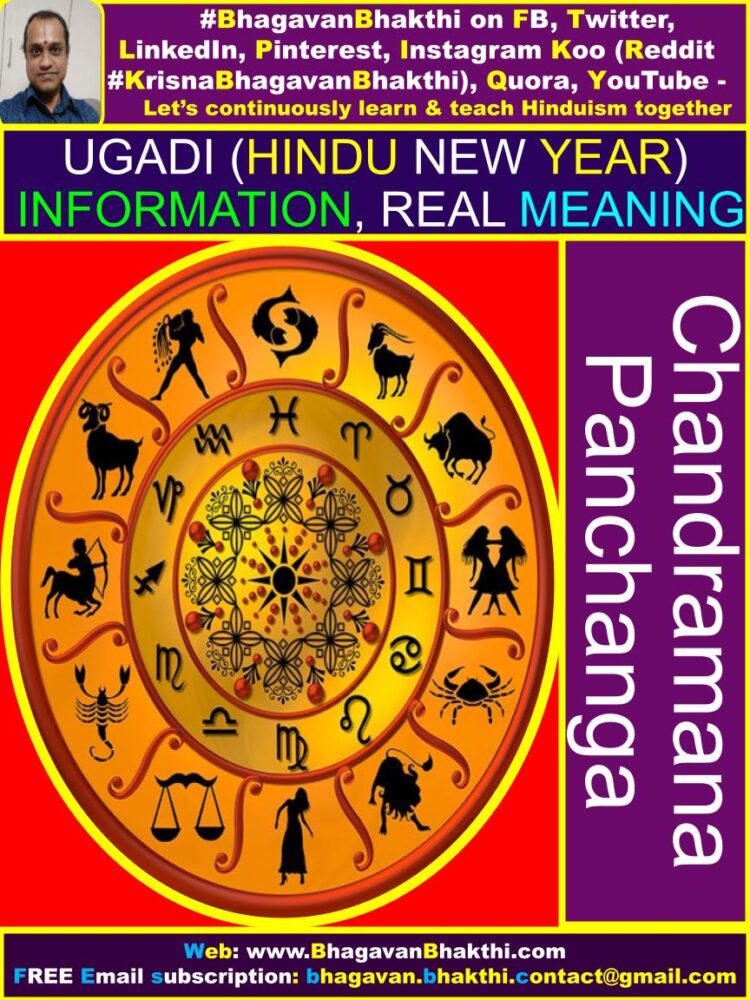
In Tamil Nadu and Kerala, Ugadi occurs as per ‘Solar Calendar’ known as ‘Sauramana’, on the day when Sun enters into Mesha (Aries) Rashi which generally happen around 13th or 14th of April every year.
While it is known as Ugadi in Andhra Pradesh and Karnataka, it is called as ‘Gudi Padwa’ in Maharastra and Goa. While in Tamil Nadu it is called as Puthandu festival, in Kerala it is known as Vishu festival.
Ugadi marks the beginning of nine day festival called Vasanta Navaratri, also known as Sri Rama Navaratri celebrated for a period of nine days ending with Sri Rama Navami. It is a Hindu tradition to begin any new activity on an auspicious note especially, if it is coinciding with Ugadi.
On this particular day, it is prescribed and it is very highly meritorious to perform ‘Thailabhyanganam’, Sun worship, ‘Nimba Kusuma Bhakshanam’, ‘Panchanga Shravanam’ etc.
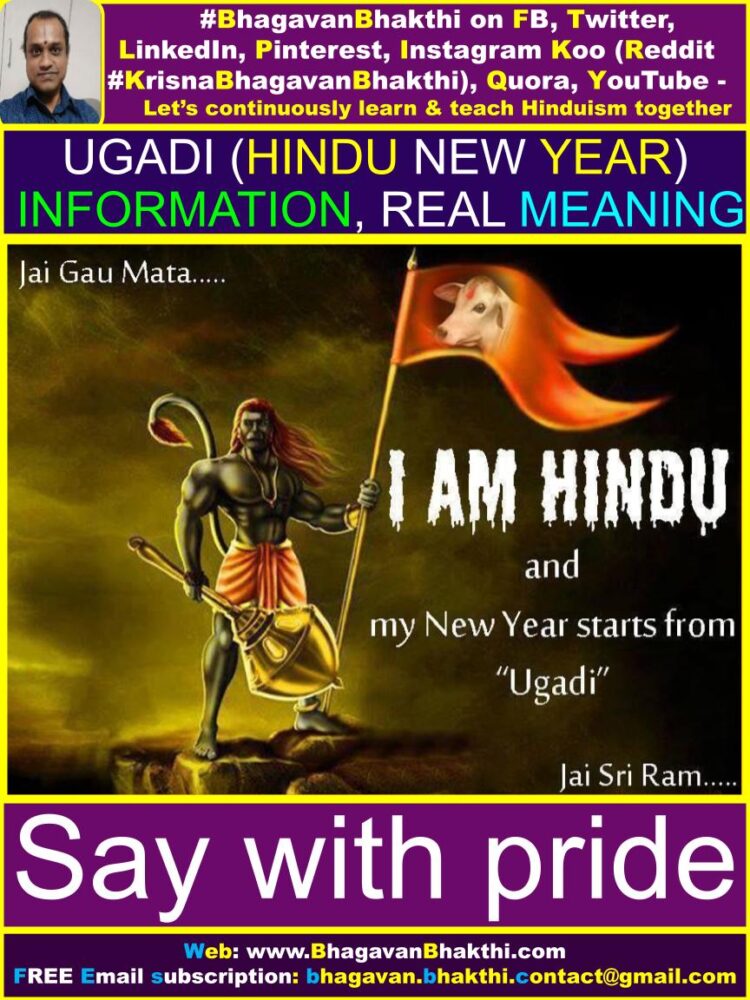
To know the “Yugadi (Ugadi) / Hindu new year, April Fools day and Roman new year relationship”, you can visit the below link:
Yugadi (Ugadi) / Hindu new year, April Fools day and Roman new year relationship
More information will be added to his post (article) on regular basis. Please visit again to know the updated information after some time.
To watch videos on #Hinduism #Sanskrit language, SUBSCRIBE to my YouTube channel from this below link:
#BhagavanBhakthi YouTube channel
To know more information about Hindu festivals details and significance, please click the below link:
Hindu festivals information, details and significance
Dear friends, if you need any clarifications about this post, kindly let me know, I will definitely try to answer all of them.
Also your one LIKE, one COMMENT, One Share, one SUBSCRIPTION is highly important.
This will help to know the quality of this content and also it will be helpful to know if any improvements is required for the content.
If you feel this content is useful to you and has helped you to improve your knowledge, kindly share this with your well-wishers.
Because “SHARING MEANS CARING”.
To receive FREE EMAIL SUBSCRIPTION about #BhagavanBhakthi, you can send an email to bhagavan.bhakthi.contact@gmail.com from your email ID.
NAMASTE!
Sri Gurubhyo Namaha
Sri Krishnaayan Namaha
Sri Krishnaarpanamastu
Subscribe / Follow us Share in Social Media